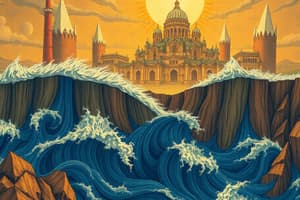Podcast
Questions and Answers
Which type of seismic wave is the fastest moving and can travel through solids, liquids, and gases?
Which type of seismic wave is the fastest moving and can travel through solids, liquids, and gases?
- Tidal Waves
- Surface Waves
- P-Waves (correct)
- S-Waves
What is the characteristic motion of S-Waves during an earthquake?
What is the characteristic motion of S-Waves during an earthquake?
- Circular
- Up and down
- Side to side (correct)
- Inward and outward
What type of waves dissipate slowly and often produce more destruction due to their low velocity and extended duration?
What type of waves dissipate slowly and often produce more destruction due to their low velocity and extended duration?
- S-Waves
- Rayleigh Waves
- P-Waves
- Surface Waves (correct)
What causes earthquakes according to the text?
What causes earthquakes according to the text?
How do P-Waves differ from S-Waves in terms of motion?
How do P-Waves differ from S-Waves in terms of motion?
What instruments do scientists use to record data about ground movement in relation to earthquakes?
What instruments do scientists use to record data about ground movement in relation to earthquakes?
Which theory suggests that the Earth's lithosphere consists of large plates that move due to convection currents in the mantle?
Which theory suggests that the Earth's lithosphere consists of large plates that move due to convection currents in the mantle?
What type of fault is characterized by rock layers sliding past each other horizontally, causing the land to sink slightly?
What type of fault is characterized by rock layers sliding past each other horizontally, causing the land to sink slightly?
What do Reverse Faults, also known as thrust faults, cause in the affected areas?
What do Reverse Faults, also known as thrust faults, cause in the affected areas?
Which type of fault causes lateral displacement between adjacent tectonic plates?
Which type of fault causes lateral displacement between adjacent tectonic plates?
Flashcards are hidden until you start studying
Study Notes
Earthquakes and Faults
Earthquakes occur when two blocks of Earth's crust move relative to one another along fractures known as faults. These movements release energy in the form of seismic waves that can cause intense shaking and damage to structures, bridges, and highways. Understanding earthquakes and their relationship with faults is crucial for managing risks associated with these natural phenomena.
Seismic Waves
Seismic waves, also called ground vibrations, are mechanical vibrations that travel through the earth during an earthquake. They radiate outward from the source of the quake, traveling through the earth like ripples spreading across water. There are three main types of seismic waves: P-waves, S-waves, and surface waves:
- P-Waves: Primary waves. These are the fastest moving waves generated by an earthquake. They push and pull rocks apart, causing them to expand and contract. P-waves travel through solids, liquids, and gases.
- S-Waves: Secondary waves. These slow-moving waves shake the ground back and forth, creating a wavy pattern. Like P-waves, they make the ground vibrate, but the motion is side to side rather than up and down.
- Surface Waves: Longer period variations of both primary and secondary waves. Surface waves have longer periods and larger amplitudes than other wave types. They dissipate slowly and often produce more destruction because of their low velocity and extended duration.
The study of seismic waves has been instrumental in understanding how earthquakes occur and where they might happen again. Scientists record data using instruments called seismographs, which measure how ground movement affects seismogram records. This information helps researchers predict future earthquakes, assess hazard potential, and reduce risk.
Plate Tectonics
Plate tectonics refers to the theory that suggests the Earth's lithosphere consists of several large plates that fit together like pieces of a mosaic puzzle overlying a semi-fluid mantle layer below. These tectonic plates move very slowly due to convection currents within the Earth's mantle. As the tectonic plates grind against each other, they create stresses in the Earth's crust, leading to the formation and movement of faults that eventually result in earthquakes.
Types of Faults
Faults are regions where the ground has moved along parallel planes relative to adjacent areas. They come in various forms and play significant roles in shaping our planet's landscape:
- Normal Faults: Occur where adjacent rock layers slide past one another horizontally. When the ground above shifts downward along this fault line, it may cause the land to sink slightly, forming what geologists call subsidence.
- Reverse Faults: Also known as thrust faults or dipping faults, these occur when a block of rock moves vertically upward relative to another block. Reverse faulting results in uplift, meaning the affected area rises higher off its original level.
- Strike Slip Faults: A type of fault in which adjacent plates slide past each other horizontally without changing the elevation between them. Strike slip faults cause lateral displacement instead of vertical movement.
In summary, understanding seismic waves, plate tectonics, and different types of faults is essential for comprehending why earthquakes occur and how we can better manage related risks. By studying the behavior of these forces beneath our feet, scientists work towards improving early warning systems, reducing structural vulnerabilities, and helping communities prepare for future events.
Studying That Suits You
Use AI to generate personalized quizzes and flashcards to suit your learning preferences.



